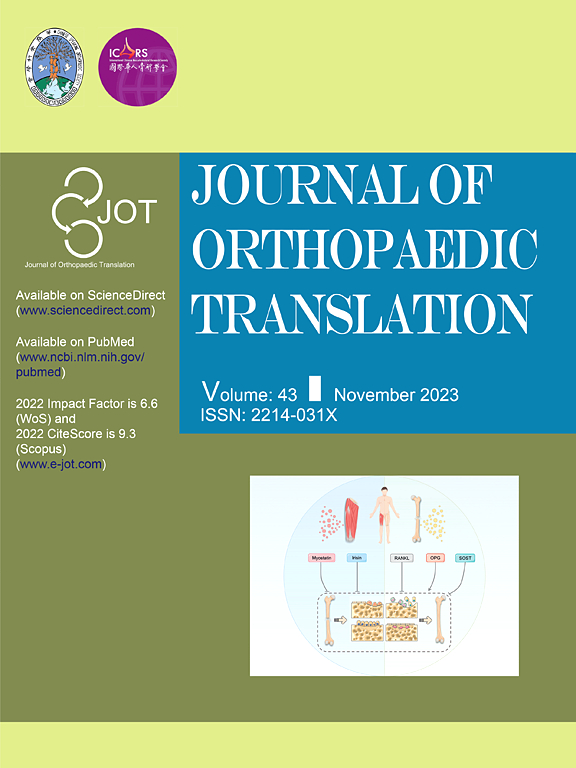COPB1缺乏症通过诱导成骨细胞铁下垂引起铁储存升高的骨质疏松症
IF 5.9
1区 医学
Q1 ORTHOPEDICS
引用次数: 0
摘要
背景骨质疏松症(OP)是一种由骨形成和骨吸收失衡引起的全身性骨代谢疾病。铁的积累已被确定为骨质疏松症的独立危险因素。铁死亡是一种新的程序性细胞死亡形式,由铁依赖性脂质过氧化作用驱动。然而,铁下垂在铁积聚性骨质疏松症中的确切作用仍不确定。方法利用蛋白质组学和ELISA技术筛选骨质疏松人群中铁积累的关键调控分子。HE染色用于评估Hamp敲除(KO)铁积累小鼠模型中骨细胞的变化。采用Western Blot、qPCR、ALP染色、茜素红染色等方法探讨sirna介导的基因敲低对MC3T3细胞株成骨分化的影响。采用ELISA、micro-CT、von Kossa染色、甲苯胺蓝染色、TRAP染色、钙黄蛋白分析等方法研究条件基因敲除小鼠的骨表型。采用RNA-seq、内质网活性探针、透射电镜(TEM)、Western Blot、共免疫沉淀(Co-IP)、流式细胞术、ChIP-seq等方法研究靶基因在成骨分化中的调控机制。采用OVX和Hamp KO小鼠建立骨质疏松模型,采用aav介导过表达的方法探讨靶基因对骨质疏松的干预作用。结果铁积累可导致骨组织中COPB1表达水平的变化。细胞和动物实验表明,COPB1缺乏可降低成骨细胞的成骨能力。转录组分析和表型实验表明,COPB1缺乏可诱导细胞铁凋亡和内质网应激。进一步研究证实,COPB1通过ATF6抑制SLC7A11转录,在内质网应激中发挥关键作用。这减少了胱氨酸的摄取,最终诱发铁下垂。过表达COPB1可以恢复细胞和小鼠的成骨功能。结论本研究阐明了COPB1在维持骨稳态中的重要作用,并强调了其作为治疗铁积累相关性骨质疏松症的潜在治疗靶点。我们的数据阐明了COPB1在维持骨稳态中的关键作用,并证明COPB1可以直接促进骨形成,使其成为未来治疗骨质疏松症的潜在治疗靶点。本文章由计算机程序翻译,如有差异,请以英文原文为准。

COPB1 deficiency triggers osteoporosis with elevated iron stores by inducing osteoblast ferroptosis
Background
Osteoporosis (OP) is a systemic bone metabolic disease that results from an imbalance between bone formation and bone resorption. The accumulation of iron has been identified as an independent risk factor for osteoporosis. Ferroptosis, a novel form of programmed cell death, is driven by iron-dependent lipid peroxidation. Nevertheless, the precise role of ferroptosis in iron accumulation-induced osteoporosis remains uncertain.
Methods
We utilized proteomics and ELISA to screen key regulatory molecules related to iron accumulation in osteoporosis populations. HE staining was used to assess osteocyte changes in Hamp knockout (KO) iron accumulation mouse models. Western Blot, qPCR, ALP staining, and Alizarin Red staining were employed to explore the effects of siRNA-mediated gene knockdown on osteogenic differentiation in the MC3T3 cell line. ELISA, micro-CT, von Kossa staining, toluidine blue staining, TRAP staining, and calcein analysis were used to study the bone phenotype of conditional gene knockout mice. RNA-seq, endoplasmic reticulum activity probes, transmission electron microscopy (TEM), Western Blot, co-immunoprecipitation (Co-IP), flow cytometry, and ChIP-seq were employed to investigate the regulatory mechanisms of the target gene in osteogenic differentiation. OVX and Hamp KO mice were used to establish osteoporosis models, and AAV-mediated overexpression was employed to explore the intervention effects of the target gene on osteoporosis.
Results
The experiments demonstrate that iron accumulation can lead to changes in COPB1 expression levels in bone tissue. Cellular and animal experiments revealed that COPB1 deficiency reduces the osteogenic ability of osteoblasts. Transcriptome analysis and phenotypic experiments revealed that COPB1 deficiency induces ferroptosis and endoplasmic reticulum stress in cells. Further investigation confirmed that COPB1 plays a key role in endoplasmic reticulum stress by inhibits SLC7A11 transcription via ATF6. This reduces cystine uptake, ultimately inducing ferroptosis. Overexpression of COPB1 can restore osteogenic function in both cells and mice.
Conclusion
This study elucidated the essential role of COPB1 in maintaining bone homeostasis and highlights it as a potential therapeutic target for treating iron accumulation-related osteoporosis.
The translational potential of this article
Our data elucidate the critical role of COPB1 in maintaining bone homeostasis and demonstrate that COPB1 can directly promote bone formation, making it a potential therapeutic target for the future treatment of osteoporosis.
求助全文
通过发布文献求助,成功后即可免费获取论文全文。
去求助
来源期刊

Journal of Orthopaedic Translation
Medicine-Orthopedics and Sports Medicine
CiteScore
11.80
自引率
13.60%
发文量
91
审稿时长
29 days
期刊介绍:
The Journal of Orthopaedic Translation (JOT) is the official peer-reviewed, open access journal of the Chinese Speaking Orthopaedic Society (CSOS) and the International Chinese Musculoskeletal Research Society (ICMRS). It is published quarterly, in January, April, July and October, by Elsevier.
 求助内容:
求助内容: 应助结果提醒方式:
应助结果提醒方式:


